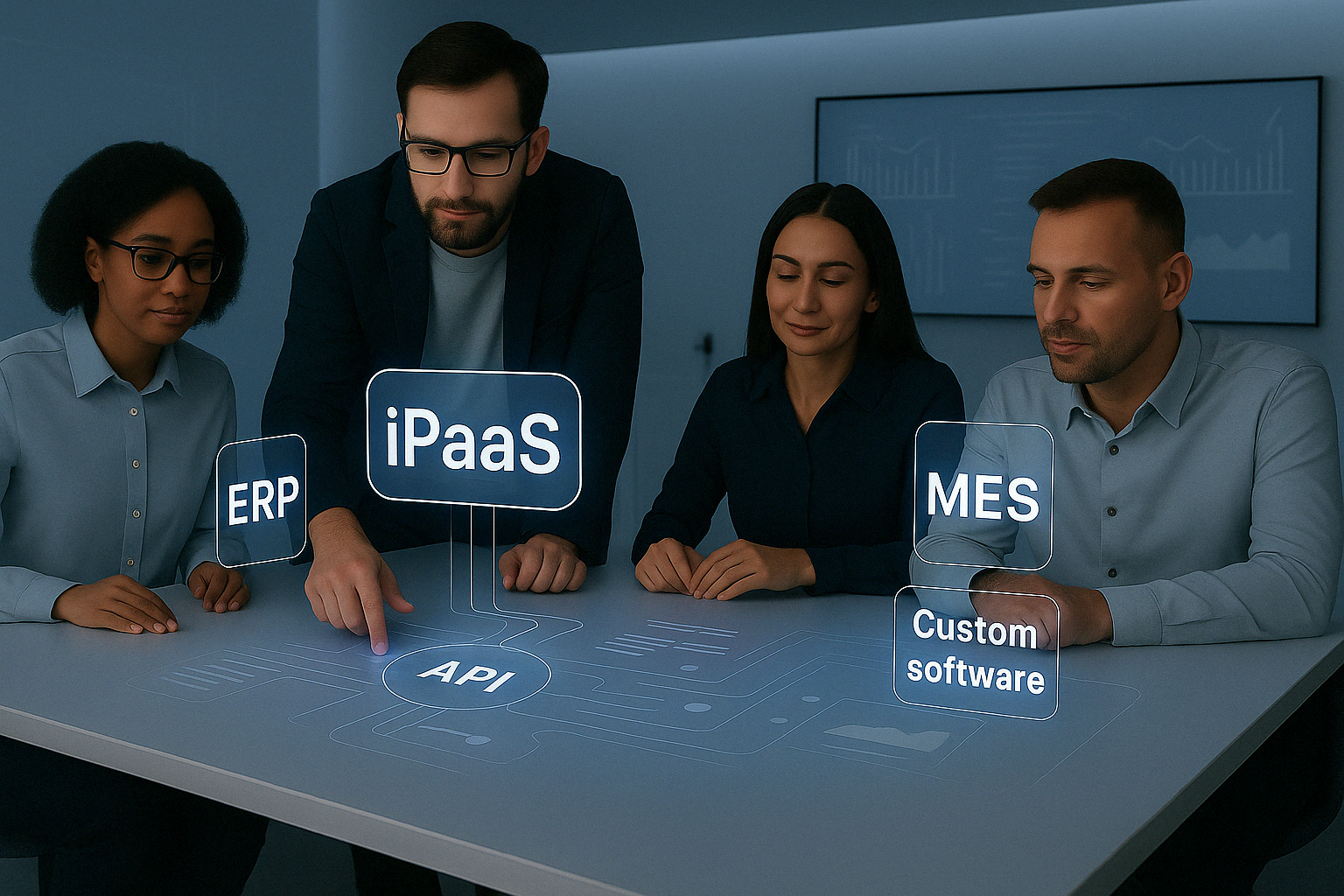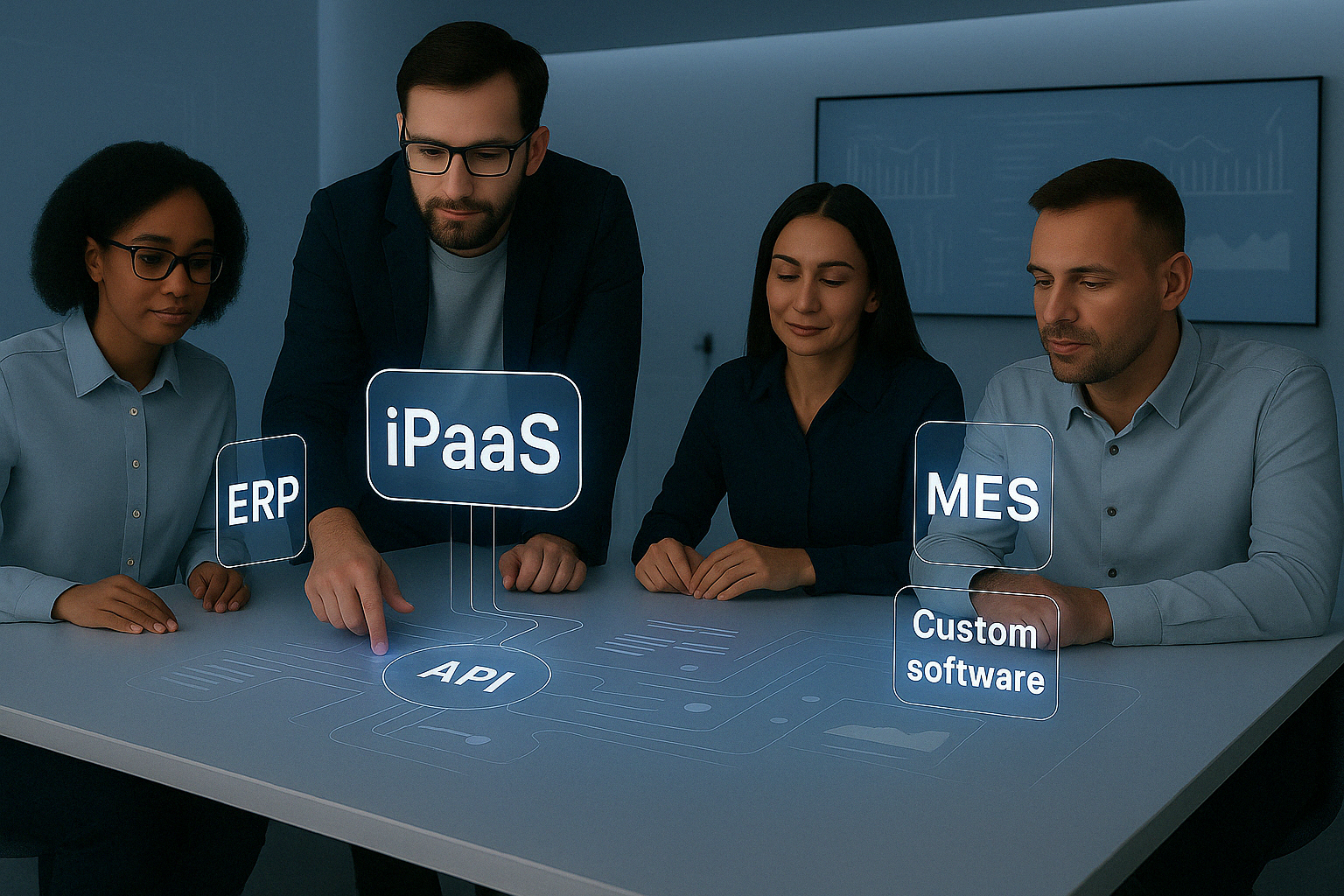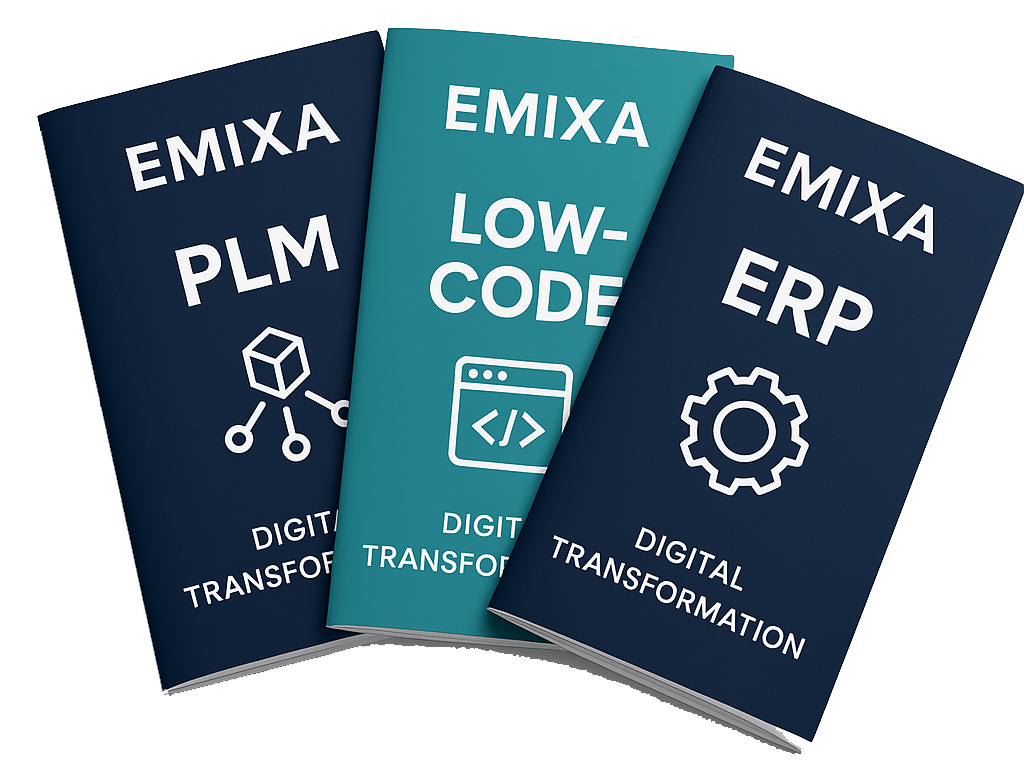
- IT
- iPaaS
Why iPaaS is a necessity in any modern application landscape

How do I get a clear picture of my IT costs while reducing the Total Cost of Ownership (TCO)? How do I shorten my time-to-market so that new products or services can be launched faster? Can my application landscape scale up during peak moments, such as Black Friday, without any problems? And how do I keep control over my business processes and avoid duplicate or unsynchronised data?
These are crucial questions that preoccupy many IT managers. However, the solution is less complex than it seems, use an Integration Platform as a Service (iPaaS). This seamlessly integrates and manages applications and data, leading to greater agility and faster response to changing market conditions.
For any modern application landscape, iPaaS is indispensable because it bundles separate systems and data sources into one integrated whole. This not only creates more operational efficiency, but also better visibility and control of the overall IT environment.
What is iPaaS?
Integration Platform as a Service (iPaaS) is a cloud-based platform that simplifies and optimizes the integration of applications within the IT landscape. It acts as a central hub to which various systems and applications can be easily connected. Thanks to a wide range of standard connectors, new applications can be seamlessly integrated, making business processes more efficient and enabling real-time optimisation. Each connector is specifically tailored to an application. If no specific connector is available, standard protocol connectors such as HTTP, FTP or JDBC can be used.
In traditional IT environments, integrations often rely on customised solutions and complex on-premises infrastructures. This usually results in high implementation costs and long lead times. iPaaS offers a future-proof solution for this. By using a cloud architecture and a low-code approach, integrations can be realised faster, more flexibly and significantly more cost-efficiently. Moreover, the platform is easily scalable: as complexity increases, iPaaS grows effortlessly along with it, without the need for additional hardware or major system modifications.
Besides integration capabilities, iPaaS also offers additional functionalities, such as data transformation, API-management and guaranteed message delivery via an event-broker. Robust security measures, including end-to-end encryption, ensure secure data transfer. Low-code approaches also lower the technical threshold, allowing organisations to implement and manage integrations faster and more flexibly.
The necessity for an integration platform
As an organisation's application landscape grows, the complexity of integrations increases rapidly. In an environment with only a few applications, linking systems directly, a so-called point-2-point integration, is often still manageable. This traditional approach usually causes few problems in the beginning. Over time, however, as the number of applications increases, this approach becomes less and less feasible. Each link requires customisation, in-depth IT knowledge and the use of different tools, depending on the specific applications.
In addition, organisations need to actively manage and maintain the integration code. As applications often use different technologies and design principles, it becomes increasingly difficult to maintain an overview. New links or modifications to existing integrations then quickly lead to complex, time-consuming and costly IT projects, with an increased risk of errors or disruptions.
![]()
The benefits of an IPaaS platform
A central integration platform such as iPaaS provides an effective solution for this and brings several benefits to organisations. By connecting applications in a standardised and centralised way, the integration process becomes easier, faster and less error-prone. Compared to traditional customised solutions, integrations can also be realised significantly faster with an iPaaS platform.
Faster integration and increased flexibility
With an iPaaS platform,applicationscan be connected much faster and easier than through traditional customised solutions. This not only speeds up implementation but also reduces costs. Thanks to the low-code approach and the wide choice of standard connectors, new links are often operational within just a few days. This reduces the risk of errors and makes managing integrations more efficient. In addition, iPaaS makes it easier to respond quickly to changes in the IT environment. New systems can be added easily, integrations with customers are faster and existing links can be adapted immediately. This reduces time-to-market, allowing organisations to remain more agile and strengthen their competitive position.
One central source of truth
iPaaS helps improve data quality and consistency by acting as a Single Source of Truth (SSOT). The platform ensures uniform data processing across the IT environment, preventing inconsistencies and data contamination. All systems are automatically synchronised, making up-to-date and reliable data available to all departments - essential for informed decision-making. This prevents errors, duplicate data and misunderstandings within the organisation. As all departments work with the same up-to-date information, decisions can be made faster and more informed. A good example of this is Tethford: there, the deployment of iPaaS ensured real-time data synchronisation, giving every department access to the right data at the right time. This led to increased efficiency and better collaboration between teams.
Seamless connectivity
Despite iPaaS being fully cloud-based managed, the platform enables smooth connectivity between on-premises systems and cloud applications. This allows organisations to flexibly extend their existing IT infrastructure without directly replacing legacy systems. For example, a manufacturing company can smoothly integrate an on-premises ERP system with a cloud-based CRM system, synchronising customer data automatically and in real-time. The scalability of the platform allows iPaaS to grow with the needs of both small and large organisations. This contributes to an agile and future-proof IT infrastructure.
How does an integration platform work?
An integration platform ensures that applications within an IT landscape can communicate with each other efficiently. At its core is the so-called runtime: a central processing layer that is responsible for running all integration processes. This runtime is installed as part of the platform and acts as the connecting link between applications. Through the runtime, applications can send data or retrieve information from it. This data is then processed, transformed and orchestrated appropriately. As applications often use different data formats, data transformation is an essential part of the process. This involves converting data from one format to another so that even incompatible systems can work together effectively.
As such, an iPaaS platform can read text files from an FTP server, convert them to the appropriate format and then store them in the database of a cloud-based SaaS application via a connector. Besides transformation, data orchestration also plays an important role. This involves collecting, merging and consolidating data from multiple sources into a standardised dataset, which is then passed on to the right application. This ensures smooth and streamlined execution of business processes. Setting up these integrations can be done in several ways. iPaaS platforms offer standard connectors, pre-built links that allow common applications to be integrated directly. When no specific connector is available, the platform can use APIs (Application Programming Interfaces). APIs provide a structured way for applications to exchange data with each other. The integration platform can both receive and send data via an API, making it a flexible and scalable solution for modern, dynamic IT environments.
![]()
Features and functionalities of an iPaaS platform
An iPaaS platform provides a flexible and efficient solution for different types of links between systems. Whether connecting business applications, exchanging data with external partners or streamlining internal processes, iPaaS enables fast and scalable integrations. A modern iPaaS platform combines several core functionalities that are essential for an effective integration landscape. The most important of these are: API Management, EDI Management and Master Data Management (MDM). Together, these components ensure secure, standardised and consistent data exchange, both inside and outside the organisation.
API Management
API Management is responsible for managing, securing and optimising APIs within the IT environment. Using an API Manager, access, performance and security are centrally controlled. Key components include an API Gateway, a Developer Portal, reporting tools and support for monetisation. The API Gateway acts as an access point for API traffic and performs access controls. At the same time, it prevents overloading by applying throttling. Through the Developer Portal, users gain insight into available APIs and can easily request access. Reporting tools provide valuable insights into usage, performance and access requests. For commercial APIs, monetisation makes it possible to set rates and payment models.
In environments with multiple systems, such as ERP, CRM and logistics applications, API management ensures a more streamlined and manageable IT environment. Functionalities such as automatic access control, real-time monitoring and centralised management increase reliability, security and efficiency. Unlike standalone solutions such as Google Apigee or MuleSoft, an iPaaS platform offers an integrated approach. This not only reduces implementation time, but also simplifies management and makes the platform easily scalable thanks to its cloud-based architecture.
EDI management
Electronic Data Interchange (EDI) enables business documents such as invoices, orders and shipping notices to be exchanged electronically in standardised formats. Unlike manual processing, which is often error-prone and time-consuming, effective EDI management ensures automated processes, lower costs and faster transactions. Integrating EDI processes within an iPaaS solution takes standardisation and automation to the next level. Thanks to the cloud architecture and pre-built connectors, organisations can easily interface with both internal systems and external partners. This reduces the risk of human error and increases the speed at which transactions are processed. In addition, the scalable design of iPaaS allows for flexible expansion of EDI functionality, without major changes to the existing IT infrastructure. This keeps organisations agile and able to respond quickly to changing or growing business needs.
Master Data Management
Master Data Management (MDM) is crucial for ensuring reliable and consistent data within organisations. In situations where data is spread across multiple systems, such as mergers, acquisitions or shared data sources, the risk of inconsistency quickly arises. An iPaaS solution with integrated MDM provides an effective solution for this. By using a publish-subscribe model, changes to data are automatically propagated to all linked systems. This ensures real-time updates and prevents erroneous or outdated information, ensuring that every application has up-to-date and uniform data.
A good example is customer data management. In many organisations, customer information is managed scattered by multiple applications. When one system makes a change, but other systems do not receive this update, data contamination quickly occurs. By managing customer data centrally in an MDM environment, it acts as a Single Source of Truth. All applications that use customer data receive updates via the MDM layer, ensuring consistency and timeliness. The so-called golden record thus forms the basis for reliable business operations. Data stewards manage this central data source and monitor the quality, usability and reliability of the data.
Besides integration and data management, iPaaS also provides insight into the business processes within the application landscape. It forms the central hub of all data flows, providing a 360-degree overview. This allows organisations to react faster to anomalies, such as delayed order processing or error messages in ERP systems. iPaaS thus supports not only technical integration, but also the broader digital transformation.

Common iPaaS platforms
Choosing a suitable iPaaS platform depends heavily on the specific integration needs, the existing IT landscape and the strategic ambitions of an organisation. There are various iPaaS solutions on the market now, each with its own features and application areas. Most platforms are commercial, such as Boomi, MuleSoft (part of Salesforce) and Informatica. There are also iPaaS solutions based on open source technology, such as WSO2, which offer organisations more freedom in customisation and management. Some integration platforms are included as part of a broader ERP ecosystem. SAP Cloud Platform Integration (SAP CPI) is a well-known example. Although this type of platform is highly integrated with the underlying ERP system, it can also lead to greater dependence on a single vendor.
When choosing an iPaaS platform, strategic considerations therefore play a major role. Many organisations consciously opt for a best-of-breed strategy: here, you select the best-fit solution on the market for each component, leading to more flexibility and often better performance. Another important consideration is avoiding vendor lock-in, where an organisation becomes completely dependent on one supplier. This can be the case, for example, when SAP CPI is chosen purely for its fit with the SAP landscape, without looking at independent alternatives. For organisations looking to professionalise or future-proof their integration capabilities, it is therefore crucial to carefully compare platforms. In particular, Boomi and Solace stand out for their distinctive approach to integration issues and their broad deployability within modern, hybrid IT environments.
Boomi
Emixa uses Boomi as its central iPaaS platform for connecting systems and data. The Boomi Enterprise Platform offers a solution in several areas such as on integration, API management and data management. A key part of this is the Master Data Hub, which allows easy central management and synchronisation of corporate data. With Boomi, links can be established between systems running on-premises, in the cloud, or hybrid. This ensures a flexible and scalable IT landscape. A good example is the collaboration with Tony’s Chocolonely. Using Boomi, their complex application landscape was brought together in one central environment. This gave the company better insight into their data, improved data quality and ensured more control over operations.
Emixa has specialist knowledge in areas such as ERP systems, e-commerce, APIs and databases. Integration projects are supervised from start to finish by a team of experienced Boomi developers. Thanks to our years of experience with Boomi, Emixa helps your organisation connect your applications smarter, improve your processes and prepare your IT environment for the future.
Solace
As an addition to Boomi, Emixa also works with Solace, an expert in event-driven architecture (EDA). Solace makes it possible to send data between systems at lightning speed and reliably, in real time. This is done via a so-called event broker, which ensures that messages always arrive at the right place. The messages are placed on so-called topics, which can be seen as categories or labels for data. Solace makes the use of these topics extra powerful by supporting wildcards. This allows systems to flexibly subscribe to multiple types of messages simultaneously - without the need for separate links.
What makes Solace unique is that multiple event brokers can be connected together to form an event mesh. This is a smart network that connects systems in different locations. This creates a reliable, scalable and fast communication channel between all parts of the IT landscape, wherever they are. Emixa helps your organisation set up this kind of modern, event-driven integration. With in-depth knowledge of real-time data processing and messaging architectures, Emixa ensures that your IT systems work well together and are ready for growth and change.
Discover what iPaaS can do for your organisation
As your organisation grows and digitises, integrating systems and applications becomes increasingly complex. Data becomes fragmented, processes no longer connect smoothly and you miss the overview. That is exactly where a powerful iPaaS platform makes all the difference. With an iPaaS platform, you bring all your integrations together in one central environment. You manage links more easily, get real-time insight into your processes and can intervene faster in case of deviations. The result? More control, higher efficiency and a future-proof IT landscape.
Would you like to find out what iPaaS can do for your organisation? The integration experts at Emixa Integration Solutions can help you find the right solution and a successful implementation. Get in touch with us. We are looking forward to helping you.
Author: Roel Kucukbiyik
Published date: August 26, 2025

Explore our Technology. Access our downloads center.
Access NowStart your Digital Transformation with Emixa

We help businesses transform their digital future with cutting-edge technology and strategic products & services




